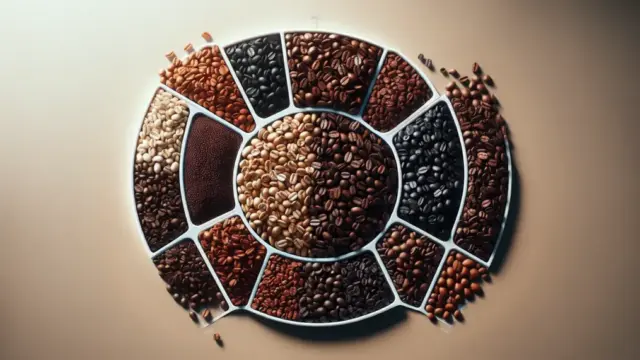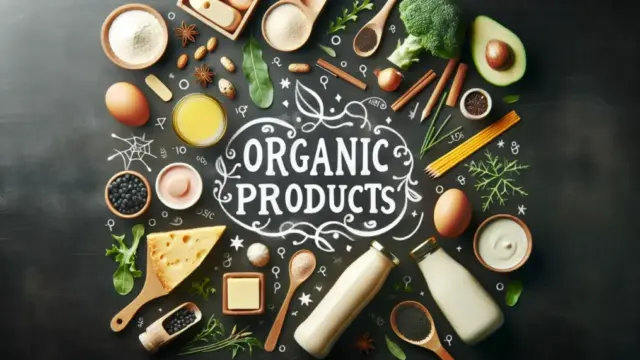Organic coffee beans are an appealing choice for health-conscious individuals, offering a natural and organic option that’s gaining popularity. In this article, we’ll dive deep into the characteristics and allure of organic coffee, providing you with tips on how to select the best beans and roast them perfectly at home. Whether you’re a seasoned coffee drinker or just starting to explore new flavors, we’ve got plenty of insights to help you find your ideal cup.
The flavor profile of coffee can dramatically change based on its origin and the roasting method used, enriching your coffee experience like never before. We’ll also share some easy brewing techniques you can try at home, so be sure to stick around until the end.
- Discover the definition and appeal of organic coffee beans
- Learn how to choose the right beans and what to check when buying
- Explore the flavor differences brought about by various roasting and brewing methods
What Are Organic Coffee Beans? Their Features and Allure
Organic coffee beans are grown with a commitment to environmental sustainability, cultivated without the use of chemical fertilizers or pesticides. This method of organic farming is gaining attention as a sustainable agricultural practice and has become an appealing choice for health-conscious coffee lovers. Let’s explore the definition of organic coffee and the benefits of its cultivation in more detail.
Defining Organic Coffee
Organic coffee refers to coffee beans that are grown according to specific standards. This includes a prohibition on pesticides and chemical fertilizers, with a focus on protecting soil and water quality. Additionally, beans produced on certified organic farms assure consumers of their quality and safety. One of the major attractions of organic coffee is the peace of mind it provides, knowing you’re drinking something safe and healthy.
Organic coffee also boasts a unique flavor profile. Thanks to natural farming methods, the beans often have a richer taste and distinctive characteristics. This means you can enjoy the flavors of your coffee while also making an environmentally conscious choice.
- Organic coffee is grown without chemical fertilizers or pesticides
- Quality and safety are guaranteed through organic certification
- The beans offer rich flavors and unique taste experiences
Advantages of Organic Farming
The primary advantage of organic farming is its minimal impact on the environment. By avoiding chemicals, it helps protect soil and water quality, maintaining the balance of ecosystems. This contributes to sustainable agriculture, ensuring a healthier planet for future generations.
Moreover, organic coffee beans are believed to positively influence health. With no harmful chemicals, they can be consumed with confidence, and they often contain a wealth of nutrients. These qualities are particularly significant for those who enjoy coffee on a daily basis.

If you found this article interesting, you might also enjoy our piece on “How to Choose and Roast Pesticide-Free Coffee Beans.” It’s filled with valuable insights on the appeal of pesticide-free coffee beans, how to select them, and roasting methods to help you enjoy a healthier and tastier coffee experience.
- It allows for sustainable agriculture with minimal environmental impact
- It may have positive effects on health
- It provides coffee beans that can be enjoyed with confidence
How to Choose Organic Coffee Beans
When selecting organic coffee beans, it’s important to keep a few key points in mind. Understanding the origin of the beans and what to check when purchasing can help you find the perfect coffee for your taste. In this article, we’ll dive into the characteristics of beans from different regions and what to look out for when buying, so you can make an informed choice.
Characteristics by Region
Coffee beans vary greatly in flavor and aroma depending on their origin. For instance, beans from Central and South America are known for their bright acidity and fruity notes. In contrast, African beans often carry floral aromas and berry-like sweetness. Meanwhile, Asian beans are characterized by their deep richness and spicy flavors.
Each region’s unique climate and soil contribute to these flavor profiles, so being mindful of your preferred origin can lead to a more satisfying coffee experience.
- Central and South American beans have bright acidity and fruity flavors
- African beans offer floral notes and berry sweetness
- Asian beans are known for their deep richness and spiciness
Key Points to Check When Buying
There are several important factors to consider when purchasing organic coffee beans. First and foremost, it’s essential to check for organic certification. A trusted certification mark ensures both quality and safety, giving you peace of mind.
Next, the freshness of the beans is a crucial factor. Choosing beans that have been roasted recently will enhance the aroma and flavor of your coffee. Additionally, consider the form of the beans—whether whole or ground—to match your preferred brewing method.

If you found this article interesting, you might also enjoy “How to Choose Coffee Beans and Dive Deep into the Charm of Acidity.” This piece offers detailed insights into selecting coffee beans and understanding acidity, making it a great read for everyone from beginners to coffee aficionados. Packed with tips to help you find your perfect coffee, it’s definitely worth checking out!
- Check for organic certification
- Choose beans with a recent roast date
- Select the form that suits your brewing method
Choosing the Right Roasting Method and Its Impact
Roasting is a crucial process that greatly influences the flavor and aroma of coffee. Once you’ve selected organic coffee beans, the next step is to consider the roasting method. Understanding the different types of roasting and their characteristics is the first step toward enjoying your favorite coffee at home. In this section, we’ll take a closer look at the various roasting styles and methods for roasting at home.
Types of Roasting and Their Characteristics
There are primarily three types of roasting: light roast, medium roast, and dark roast. Light roasts maximize the beans’ natural flavors, offering a fruity profile with noticeable acidity. In contrast, medium roasts strike a perfect balance, allowing you to savor both acidity and richness. Dark roasts are known for their deep body and bitterness, with a strong, toasty flavor that many coffee lovers find appealing.
Each roasting style creates distinct differences in the coffee’s taste. Choosing the right type of roast to match your preferences can lead to a more satisfying coffee experience.
- Light roast features fruity notes and noticeable acidity
- Medium roast offers a nice balance of acidity and richness
- Dark roast is characterized by deep flavor and a robust toastiness
Roasting Coffee at Home
Roasting coffee at home is a fantastic way to enjoy rich flavors with ease. Using a home roaster allows you to evenly roast the beans to your desired level of doneness. If you don’t have a roaster, you can still roast coffee using a skillet or an oven.
It’s essential to pay attention to the color and aroma of the beans as you roast. As the roasting process progresses, a delightful aroma will start to emerge, so be sure to stop the roasting at the right moment to capture the desired flavor. Home-roasted beans provide a fresher and more fragrant cup of coffee.
- A home roaster allows for even roasting
- You can also roast using a skillet or an oven
- Monitoring aroma and color during roasting is key
Brewing Methods and Their Flavor Differences
The taste of coffee can vary significantly based not only on the roasting process but also on the brewing method used. When working with organic coffee beans, selecting the optimal brewing technique can help unlock the full range of flavors within the beans. In this section, we’ll introduce the main brewing methods and delve into how extraction time and temperature can impact the taste.
Overview of Main Brewing Methods
There are several primary brewing methods for coffee, including drip, French press, espresso, and siphon. Drip brewing is known for its light and refreshing flavor, allowing you to savor the nuances of the beans. French press, on the other hand, extracts the oils and fine particles from the beans, resulting in a rich and full-bodied taste.
Espresso is made under high pressure, resulting in a bold and creamy finish. Siphon brewing is visually captivating and enhances the aroma and flavor of the coffee. By choosing a method that suits your taste preferences, you can elevate your coffee experience to new heights.
- Drip brewing offers a light and refreshing flavor
- French press provides a rich and full-bodied experience
- Espresso delivers a bold and creamy finish
The Importance of Extraction Time and Temperature
Extraction time and temperature are critical factors that directly influence the flavor of your coffee. Generally, a longer extraction time can lead to a stronger bitterness and astringency in the coffee. Conversely, if the extraction time is too short, the coffee may become overly acidic. Finding the right extraction time that suits your taste is essential.
Similarly, brewing at the appropriate temperature can maximize the flavor extraction from the coffee. The ideal temperature range is typically between 90°C and 95°C (194°F to 203°F). This ensures that the coffee’s aromas and flavors are fully expressed, allowing you to enjoy a more vibrant cup of coffee.
- Longer extraction times can lead to increased bitterness and astringency
- Short extraction times may highlight acidity too much
- The ideal brewing temperature is between 90°C and 95°C
Conclusion
In this article, we’ve explored the ins and outs of selecting organic coffee beans, roasting them, and brewing the perfect cup. Organic coffee beans are cultivated using environmentally friendly methods, resulting in rich flavors and a healthier choice for coffee lovers. The origin of the beans and the roasting techniques used can significantly alter the taste, so it’s essential to pick what suits your palate best. Furthermore, the brewing method, timing, and temperature can also influence the flavor of your coffee, making it crucial to pay attention to these details as you enjoy your brew.
With this knowledge in hand, we encourage you to fully savor the charm of organic coffee in the comfort of your home. Discovering your own unique cup can elevate your coffee experience to new heights. So, why not grab some organic coffee beans and start your wonderful coffee journey today?
- Organic coffee beans are an environmentally friendly and healthy choice.
- The flavor can change dramatically depending on the roasting and brewing methods.
- Choosing beans and methods that match your preferences will lead to a more satisfying coffee experience.
We’d love to hear about your coffee experiences in the comments! Your cup could inspire someone else’s next discovery.









































































Comment